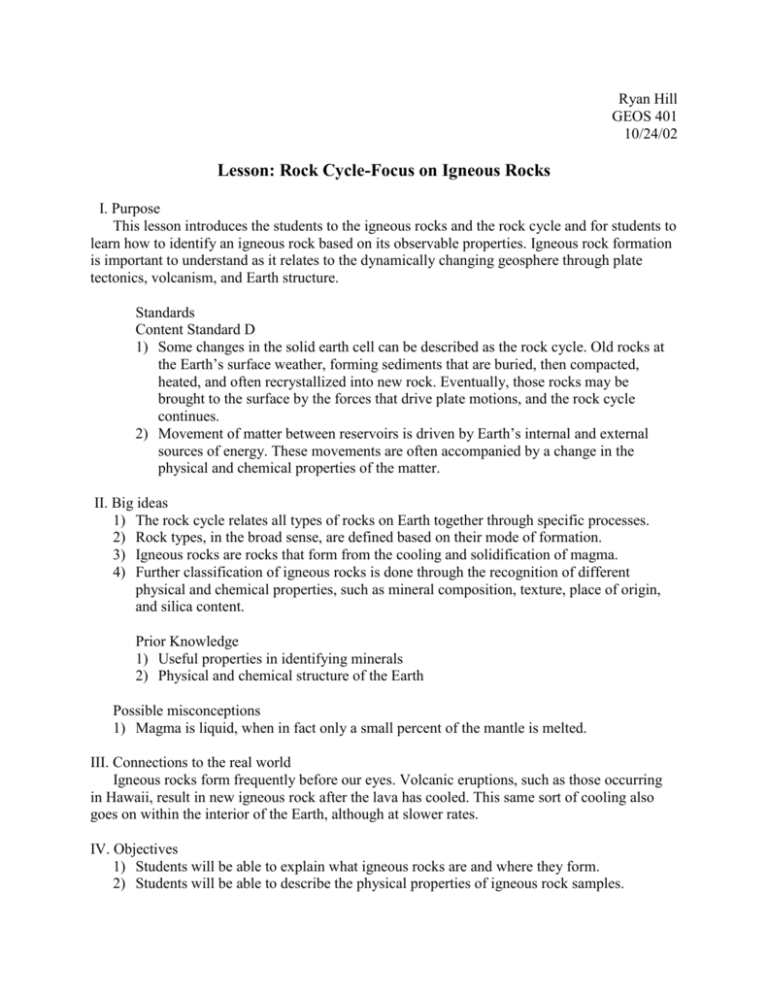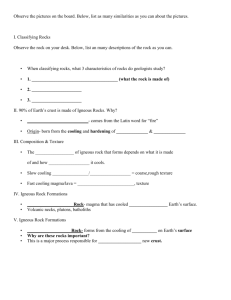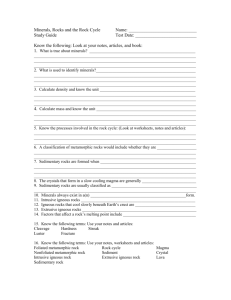doc - University of Arizona
advertisement

Ryan Hill GEOS 401 10/24/02 Lesson: Rock Cycle-Focus on Igneous Rocks I. Purpose This lesson introduces the students to the igneous rocks and the rock cycle and for students to learn how to identify an igneous rock based on its observable properties. Igneous rock formation is important to understand as it relates to the dynamically changing geosphere through plate tectonics, volcanism, and Earth structure. Standards Content Standard D 1) Some changes in the solid earth cell can be described as the rock cycle. Old rocks at the Earth’s surface weather, forming sediments that are buried, then compacted, heated, and often recrystallized into new rock. Eventually, those rocks may be brought to the surface by the forces that drive plate motions, and the rock cycle continues. 2) Movement of matter between reservoirs is driven by Earth’s internal and external sources of energy. These movements are often accompanied by a change in the physical and chemical properties of the matter. II. Big ideas 1) The rock cycle relates all types of rocks on Earth together through specific processes. 2) Rock types, in the broad sense, are defined based on their mode of formation. 3) Igneous rocks are rocks that form from the cooling and solidification of magma. 4) Further classification of igneous rocks is done through the recognition of different physical and chemical properties, such as mineral composition, texture, place of origin, and silica content. Prior Knowledge 1) Useful properties in identifying minerals 2) Physical and chemical structure of the Earth Possible misconceptions 1) Magma is liquid, when in fact only a small percent of the mantle is melted. III. Connections to the real world Igneous rocks form frequently before our eyes. Volcanic eruptions, such as those occurring in Hawaii, result in new igneous rock after the lava has cooled. This same sort of cooling also goes on within the interior of the Earth, although at slower rates. IV. Objectives 1) Students will be able to explain what igneous rocks are and where they form. 2) Students will be able to describe the physical properties of igneous rock samples. V. Assessment instruments This lesson has a slide show that goes over the basic characteristics of igneous rocks. Much of the information presented leads to logical questions of understanding. For example, the slide showing the order of crystallization of magmas leads one to ask why the entire magma does not just cool and solidify uniformly. Students will be asked these sorts of questions throughout the slide show and given 2-3 minutes to respond. Some students will be called upon to share their ideas. When rock properties are covered, samples of rocks will be distributed. Students will be asked to apply what they have learned to the rock sample and to describe the rock’s physical and chemical properties. VI. Activities Introduction This lesson follows the lesson on minerals and mineral properties. Review what was learned about how to classify a mineral. The method used to group, classify, and describe minerals can be applied to rocks. Introduce that all rocks are interconnected through the rock cycle. Establish with the students that they will be studying the rock cycle in sections. Today, they will only be focusing on the igneous rock portion. Activity Use the slide show as a tool for teaching about all the important aspects of igneous rock. It is important to intersperse questions of understanding throughout the slide presentations, so that the students remain engaged and the class is focused on their learning. Begin with what an igneous rock is and how it forms. Explain that an igneous rock is the result of the solidification of magma in the mantle and crust. Pose the question: “Why do magma’s show a limited range of compositions?” This requires prior knowledge of the structure of the Earth lessons. The Earth is layered, based on physical properties such as density. Since partial melting only occurs in a small portion of the Earth’s mantle, there is not much room for variation in magma, and consequently, rock composition. Lead the students through a discussion on this question and guide them to the correct explanation. Move on to classification of igneous rocks. Ask students if they know of different places where igneous rocks can form. These should be on the surface and in the Earth’s interior. Define intrusive and extrusive. Define the different types of igneous rock texture. At this point, pass out samples of igneous rocks and have students describe the texture and it’s general location of origin. Move on to chemical and mineralogical composition. Ask students if they notice any common minerals that appear in their rock samples. For rocks that are noticeably different, ask students what they notice about the differences (i.e., color). Explain that these observations have a classification scheme. Continue with slide show and go over the common minerals and the classification schemes associated with mineral content (i.e. mafic, felsic, etc.). Have students appropriately classify the rock samples in front of them. Activity 2: Break the students up into groups of four and tell them that they are going to learn the difference in how intrusive and extrusive rocks form. Have the students put on safety equipment such as goggles and mitts and instruct them to use a heat source (such as Bunsen burners, or whatever is available) to heat a tablespoon of powdered sulfur until it melts into a dark red liquid and pour it onto a paper plate to cool. Have them repeat the process, only this time have them pour the melted sulfur into a paper cup with water. Have them compare the newly formed solids. Be sure to clarify to them that this is only an example. Make it clear to them that this is just a way to illustrate rates of cooling. Do not let them get the idea that the interior of the Earth is completely a liquid. (We’re not sitting on a lake!) Summary Review with class what they have learned today. Ask them conceptual questions that get at the main points of the lesson: 1) What is an igneous rock? 2) Where can igneous rocks form? 3) Why isn’t magma completely melted? 4) Describe the fundamental difference in formation that distinguishes intrusive and extrusive igneous rocks VIII. Materials 1) Projector 2) Computer 3) Slide show from: http://web.earthsci.unimelb.edu.au/TeachingSupport/102%20PDF%20Files%202001/102 %20Lect04.pdf 4) Igneous rock samples 5) Hand lens 6) Safety goggles 7) Gloves, oven mitts 8) Powdered sulfur 9) Bunsen burners Note: The intrusive/extrusive activity has been reformatted from a lesson written by Deborah Hanuscin of the Indiana Geological Survey at Indiana University. The original lesson plan can be found online at http://igs.indiana.edu/geology/rocks/rockcycleactivities/moltenmagic.cfm








